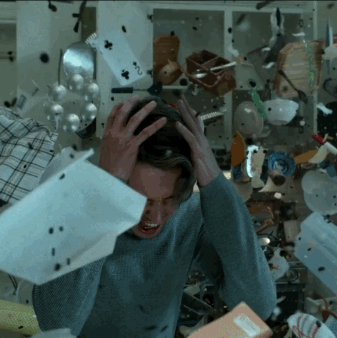
Stylish, strange, and serpentine, FX’s Legion is in no way a conventional superhero show, despite being based on a character from Marvel Comics’ spandex-clad X-Men mythology. That said, it does retain one trope from its comic-book origins: superpowers. Protagonist David Haller (Dan Stevens) has a set of mysterious metahuman abilities, one of which is the capacity to move objects with his mind. That particular trait comes into stunning display in tonight’s pilot episode when a stressed-out David inadvertently causes the drawers and cabinets of his kitchen to fly open and eject all of their contents in slow motion. Watching the scene, you would be forgiven for thinking those swirling objects were spun with CGI and tossed around via ones and zeroes. But you would be wrong — astoundingly enough, the kitchen scene was done with practical effects.
“All those elements are real elements,” says showrunner Noah Hawley. There’s a little bit of trickery insofar as Stevens wasn’t on set when the props went flying — a wise choice, as killing your star in the pilot isn’t generally in the best-practices manual. Stevens didn’t quite get that in the beginning. “I was a little worried when they said it at first,” Stevens told us. “It was like, ‘I’m going to be standing there?’” Luckily, the answer was no. His takes were solo shots where, as Hawley puts it, the actor would be “standing in the kitchen, throwing up his hands as if the room’s exploding.”
But after that, they actually did explode the room. “Literally, we got a lot of air cannons and we blew a lot of stuff out of the cabinets,” Hawley says. Production designer Michael Wylie estimates that they used between 30 and 40 air cannons at once, shooting off an insane number of individual objects — which made for a tall order for the props department. “The set decorator had to go and find all of that stuff and have doubles and triples on it,” Wylie says.
The trick was in the camera. “We got this amazing camera device called the Bolt,” Wylie recalls. “It’s this 2,000-pound unit and it’s on a track. It will do a two-second move, or three-second move, and it shoots about 1,000 frames a second. It’s motion-controlled, so it’s repeatable.” After shooting the exploding room at that incredibly high frame-rate, they had the raw material for a 3-D spin in a kitchen of chaos. At that point, they could use just a wee smidgen of CGI compositing to layer their footage of Stevens into the finished product, his svelte body and stubbled chin unharmed.
Stevens was agog about the finished product. “Everything looks cool in slo-mo anyway, but 1,000 frames per second? When you see these playing cards and spaghetti and Pringles and knives and things just flying through the air?” he says. “There was something in at least every episode that every department had never quite done before. Everybody was being pushed to their creative limits. And all of the acting department were like, ‘We’ve certainly never done anything like this before. What is going on?’” If Hawley has his way, the audience will be asking that same question every episode.

